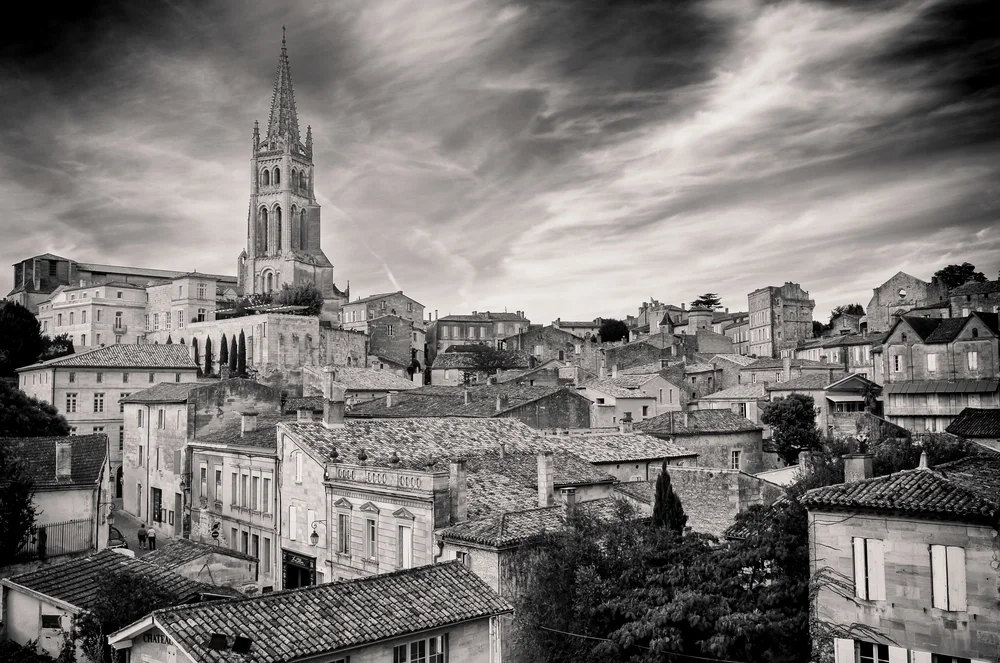
Simon Field MW’s voyage through the 2022 Bordeaux en primeur tastings reaches St-Emilion, where a tricky period may finally be drawing to a close.
“We have to keep the gates closed in the summer,” says Matthieu Cuvelier, managing director of Clos Fourtet and scion of the family who bought the property in 2000. Clos Fourtet borders on the medieval town of St-Emilion and has a clear view of its bell tower and Collegiate church—and also of a sizable number of visitors, who appear to be heading in our direction. Not quite barbarians at the gate, and it is easy, in any event, to see the attraction of the modest honey-bricked château (18th century) and its vines which cascade down from the plateau.
Cuvelier is excited about the ‘22s. “A surprise” soon becomes inflated to “a miracle”; the wines, he says, are the best made in the two decades of Cuvelier ownership, and by some distance. The eve of the 2022 en primeur campaign this may well be, but the hyperbole seems genuine, the enthusiasm infectious. All the more so as it seems as if this year it is the turn of the Merlot varietal to shine, primus inter pares for a change.
Clos Fourtet is located on the finest of St-Emilion’s heterogeneous soils, where the clay and the limestone have conspired not only to preserve the water in this sweltering year, but also to regiment the acidity and to gift an energy and a freshness to the wines which, otherwise, may have been leaden or at the very least ponderous. “To think,” jokes Matthieu, “that all the talk recently has been of abandoning Merlot and trying out other, less generous varietals.” That discussion has now been put on hold.
A new dawn?
Good timing for St-Emilion, one tends to think. The appellation, steeped in the history of the Jurade and the colourful “Nuit de patrimonie” red robes aplenty, has had a tricky time of it of late. When, in 1955, its classification was established, the idea was to avoid any risk of stagnation or of a betrayal of terroir. A counterblast, many thought, to the petrified system which had been inaugurated across the river in the Médoc a century previously, with its contentious adherence to the supremacy of property over terroir. The classification in St-Emilion was to be fluid (updated every decade in other words) and it was to be based on the primacy of the land above all else. So far so good. And so good it seemed until 2006, with a degree of stability provided by the two leading houses (Cheval Blanc and Ausone, classified as Premier Grand Cru Classé A) and just enough movement beneath this to keep everyone else on their toes.
Since 2006, however, things have gone dramatically wrong. In essence there has been minimal respect for the mechanic of judgment and even for those selected to make these judgments; this, allied to a natural inclination of anyone unlucky enough to be demoted to kick up a fuss, has proved extremely inauspicious for the appellation.
Several court cases later, the classification of 2022 is seen as precarious at best, our two cheerleaders having abdicated altogether, and several other châteaux volubly discontented with the status quo. The house of cards started to fall in 2006 for a variety of reasons, most telling maybe the fact that two houses (Figeac and La Gaffelière) were denied promotion to Premier Grand Cru Classé A, because, can you believe it, their wines were deemed not to be selling for a high enough price.
Commercial imperatives had trumped the virtues of terroir, in spite of all the noble aspirations rehearsed above. The owner of Figeac, the late Thierry Manoncourt, was far too dignified to make a formal complaint, but the damage had been done and discontent started to manifest itself across the village. July 2021 was the nadir when both Cheval Blanc and Ausone walked away from the classification system, advising that, in their view, it no longer reflected both the quality of the terroir and, as a direct consequence, the quality of the wine itself.
Those who take the long view may say that this is all down to the fact that the jurisdiction of the Jurade, dating from the 12th century, was entirely dictated by political and economic impulses, resulting, ultimately, in the fact that the current boundaries of St-Emilion cover such a diverse expanse of terroir. Blame Edward II of England, in other words!
Unprecedented quality
This, in brief, is where St Emilion finds itself in 2023. Politics aside, April has thus far, with one minor scare, decided not to visit frost upon the vines. The sun is shining, the town is already bustling, and over the next few weeks the international wine trade will descend to confirm (surely) the unprecedented quality of the 2022 vintage.
Matthieu Cuvelier is very optimistic and, tasting his wines (including an excellent Poujeaux, the Cuvelier property in Moulis), it is easy to see why. Such power and quality of fruit, and yet such a joyful lightness of touch; I have been treated to a magnificent Clos Fourtet 2022. My only disappointment is that the Les Grandes Murailles label, celebrating the fact that one of St-Emilion’s ancient (eponymous) landmarks lies within the boundaries of Clos Fourtet, has this year been discontinued, deemed to be just too small to be a stand-alone cuvée. Its excellent old vine, Merlot, has, nevertheless, served to boost yet further the quality of the grand vin.
One can only hope that the confidence sure to be engendered by the ensuing campaign will calm the waters. Clos Fourtet confirms the quality that can be achieved at Premier Grand Cru Classé (B) level, and Figeac’s recent promotion to the top of the hierarchy, (it now joins Château Pavie as the second Premier Grand Cru Classé A) albeit long overdue, may signal the end to the disruption. One can only hope so.
2022 Bordeaux Field Notes: Heightened expectations






